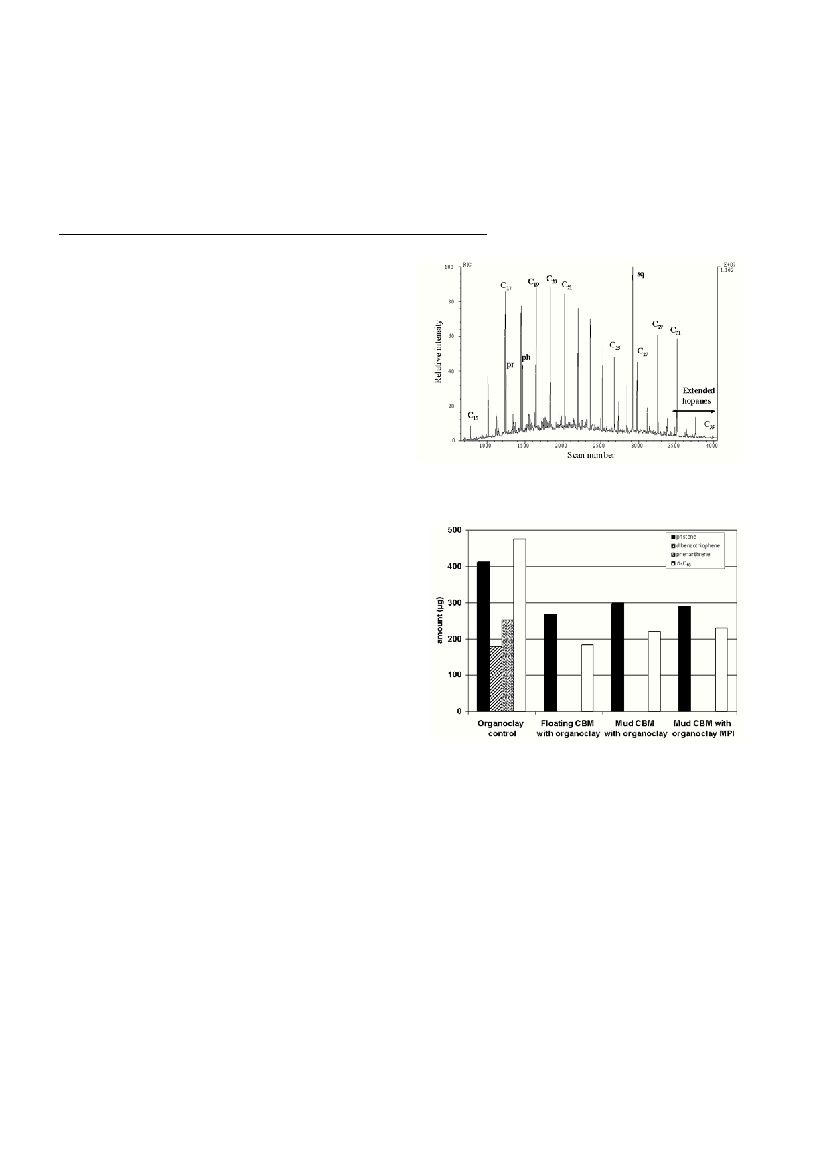209
Rapp. Comm. int. Mer Médit., 36,2001
Introduction
The Gaza Strip along the eastern Mediterranean Sea is a coastal area
of about 365 km
2
(45 km long and 6-12 km wide). Coastal and sea
water pollution is one of several serious problems currently affecting
the Gaza Strip (1). At present, significant oil pollution exists along the
Eastern Mediterranean coast (2). Wadi Gaza is the only surface water
in Gaza Strip. It is used for disposal of sewage water, solid waste, and
agricultural and industrial waste water (3). The eastern part of the wadi
is in?uenced by untreated waste-water discharge. The effluent from
the Gaza City treatment plant is discharged into Wadi Gaza and then
disappears in the dunes and partly reaches the sea (4). Cyanobacterial
mats (CBM) develop in the western part of the wadi close to the coast
of the Mediterranean Sea. They are naturally exposed to ?uctuating
salinity due to seasonal sea-water intrusion and fresh-water run-off. In
recent years there was increasing concern over the fate of petroleum
hydrocarbons in marine ecosystems since several of these compounds
are known to exhibit toxic, mutagenic or carcinogenic properties (5,6).
We investigated the pollution in Wadi Gaza and carried out a screen-
ing experiments for biodegradation of petroleum model compounds by
natural CBM.
Materials and methods
Cyanobacterial mats and freeze-dried sediments from Wadi Gaza
were extracted with dichloromethane (DCM)-methanol-water 1:2:0.8
(v/v/v) and DCM, respectively.The sediment extracts were separated
into aliphatic, aromatic and NSO fractions and analyzed by gas chro-
matography (GC) and GC-mass spectrometry. CBM from Wadi Gaza
were inoculated into 100 ml autoclaved sea water with ammonium
chloride (1 mM) and phosphate (8 µM). Pristane, n-octadecane,
phenanthrene, and dibenzothiophene as petroleum model compounds
(PMC) were added by means of organo-clay complexes (OCC;
adsorbed on benzyl- trimethylammonium montmorillonite). 50 mg
OCC containing 1.65 mg of each compound were added. The experi-
ments were carried out in Erlenmeyer ?asks incubated on a rotary
shaker (70 rpm, 28°C) under 12 h light /12 h dark conditions.
Uninoculated ?asks containing medium and OCC served as controls to
estimate PMC loss during the incubation period. PMC were extracted
with DCM-methanol-water 1:2:0.8 (v/v/v) and quantified by GC.
Results and discussion
The analyses show that the sediments are contaminated with
petroleum to variable levels. The aliphatic fractions are dominated by
n-alkanes up to n-
C
3
5
(Figure 1). n-Alkane distributions with maxima
between n-
C
1
9
and n-
C
2
1
are attributed to pollution by diesel oil. A pre-
dominance of n-
C
2
7
, n-
C
2
9
and n-
C
3
1
is due to the contribution of high-
er plants growing along the wadi. Elevated concentrations of the C
1
7
n-
alkane partly originate from cyanobacteria. The contribution of diesel oil
or other petroleum deriva
t
ives is further indicated by the presence of fos-
sil fuel biomarkers, e.
g.pristane, phytane, and extended 17
a
,
2
1
ß
-
hopanes in the aliphatic hydrocarbon fractions, and methyl- and
e
t
hylphenanthrenes and methyl- and ethyldibenzothiophenes in the aro-
matic hydrocarbon fractions. Increased pristane/C
1
7
ratios show that
slight biodegradation occurred. In a screening experiment the cy
a
n
o
b
a
c-
terial mats from Wadi Gaza degraded the aromatic hydrocarbons within
forty days. Also the aliphatic compounds were degraded to a large ex
t
e
n
t
(Figure 2). This shows that natural cyanobacterial mats from polluted
e
nvironments are well adapted to efficiently degrade pollutants.
B
i
o
d
egradation can be considered as potential tool for the cleaning of oil-
contaminated marine and coastal environments. Further inve
s
t
i
ga
t
i
o
n
s
will be carried out in the field to be relevant for oil spill incidents.
References
1. SafiJ. M., 1998. The state of the environment in Gaza Strip.
Alexandria Science Exchange, 19: 137-150.
2. Rullkötter J., Cohen Y. and SafiJ., 2000. Bioremediation of marine
pollutants by marine cyanobacterial mats An interdisciplinary approach.
CIESMWorkshop Series, 11: 51-52.
3. Moshtaha A. E., 1999. Lower part of Wadi Gaza inside Gaza Strip:
geomorphological study. Ph.D. Thesis, Al-Nilin University, Republic of
Sudan.
4. Nashashibi M. and van Duijl L. A. 1995. Wastewater characteristics in
Palestine.Wat. Sci. Tech., 32: 65-75.
5. Hanson K. G., Nigam A., Kapadia M. and Desai A. J., 1997.
Bioremediation of crude oil contamination with Acinetobactersp. A3.
Current Microbiology, 35: 191-193.
6. Radwan S. S. and Al-Hasan R. H., 2000. Oil pollution and
cyanobacteria. In: Whitton B. A. and Potts M. (eds.), The Ecology of
Cyanobacteria, pp 307-319
FOSSIL FUEL POLLUTION IN WADI GAZA AND BIODEGRADATION OF PETROLEUM MODEL
COMPOUNDS BY CYANOBACTERIAL MATS
Nimer M. D. SAFI
1,2
*, Jürgen KÖSTER
1
, and Jürgen RULLKÖTTER
1
1
Institut für Chemie und Biologie des Meeres, Carl von Ossietzky Universität Oldenburg, Oldenburg, Germany.
2
Environmental Protection and Research Institute, Gaza, Gaza Strip, Palestine - n.safi@icbm.de
Abstract
Coastal and sea water pollution is one of several serious problems currently affecting the Gaza Strip. Sediments and cyanobacterial mats
inWadi Gaza are exposed to various levels of pollution mainly with diesel oil. Screening experiments show that petroleum model
compounds (pristane, n-octadecane, phenanthrene, and dibenzothiophene) are efficiently biodegraded by cyanobacterial mats from Wadi
Gaza.Within forty days, the aromatic compounds disappeared completely, and the aliphatic compounds were degraded to a large extent.
Keywords: Pollution; petroleum hydrocarbons; cyanobacterial mats; biodegradation.
Figure 1. Representative gas chromatogram of an aliphatic
hydrocarbon fraction of Wadi Gaza sediment polluted with
diesel oil. Major peaks are n-alkanes (carbon numbers are indi-
cated). Pr: pristane, ph: phytane, sq: squalane (internal stan-
Figure 2. Biodegradation experiment with ?oating and benthic
cyanobacterial mats from Wadi Gaza. Aromatic petroleum
model compounds (added by means of organo-clay complex-
es) were degraded completely after 40 days.

